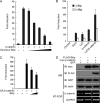Xenopus skip modulates Wnt/beta-catenin signaling and functions in neural crest induction
- PMID: 20103590
- PMCID: PMC2856295
- DOI: 10.1074/jbc.M109.058347
Xenopus skip modulates Wnt/beta-catenin signaling and functions in neural crest induction
Abstract
The beta-catenin-lymphoid enhancer factor (LEF) protein complex is the key mediator of canonical Wnt signaling and initiates target gene transcription upon ligand stimulation. In addition to beta-catenin and LEF themselves, many other proteins have been identified as necessary cofactors. Here we report that the evolutionally conserved splicing factor and transcriptional co-regulator, SKIP/SNW/NcoA62, forms a ternary complex with LEF1 and HDAC1 and mediates the repression of target genes. Loss-of-function studies showed that SKIP is obligatory for Wnt signaling-induced target gene transactivation, suggesting an important role of SKIP in the canonical Wnt signaling. Consistent with its involvement in beta-catenin signaling, the C-terminally truncated forms of SKIP are able to stabilize beta-catenin and enhance Wnt signaling. In Xenopus embryos, both overexpression and knockdown of Skip lead to reduced neural crest induction, consistent with down-regulated Wnt signaling in both cases. Our results indicate that SKIP is a novel component of the beta-catenin transcriptional complex.
Figures








References
Publication types
MeSH terms
Substances
LinkOut - more resources
Full Text Sources
Miscellaneous

